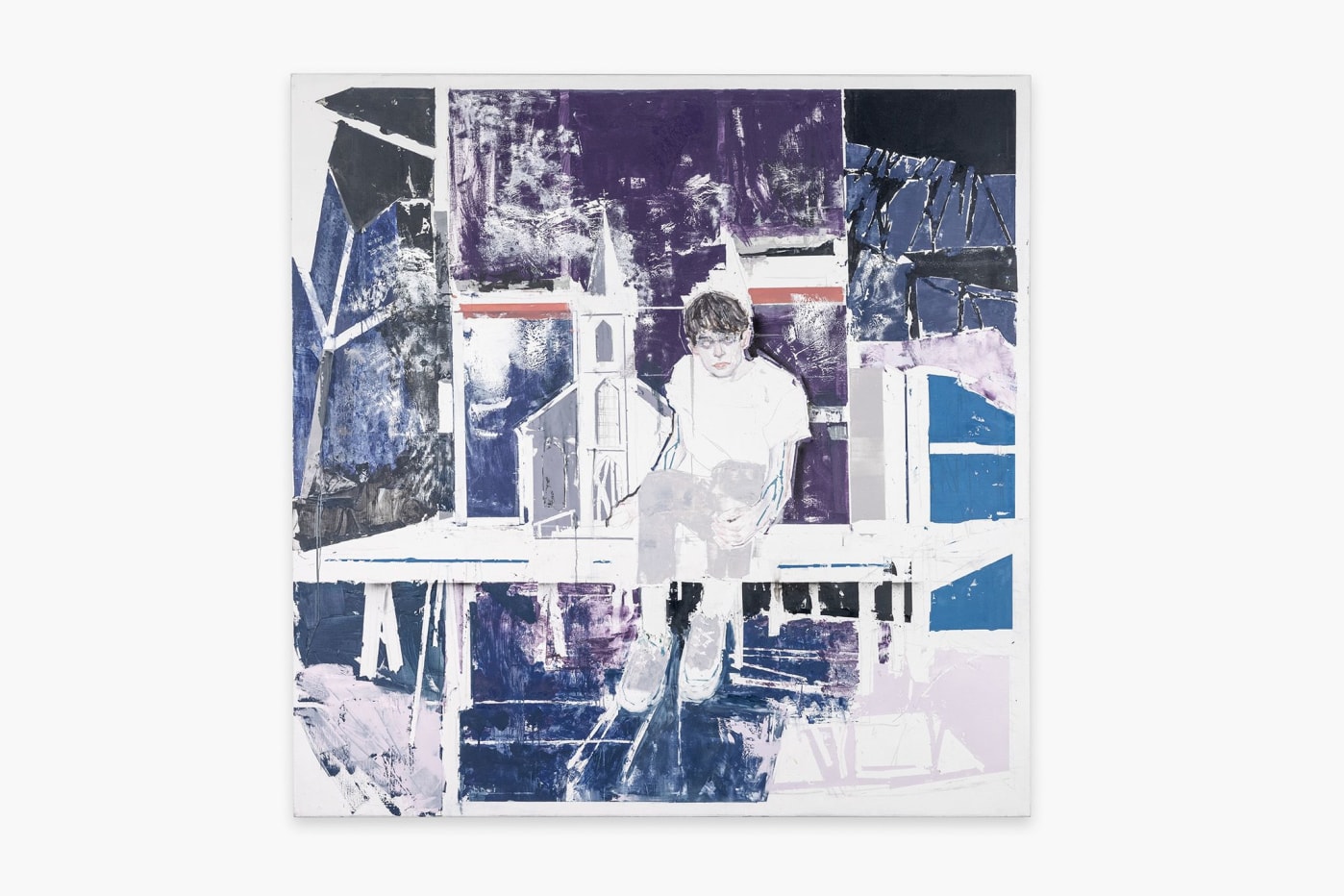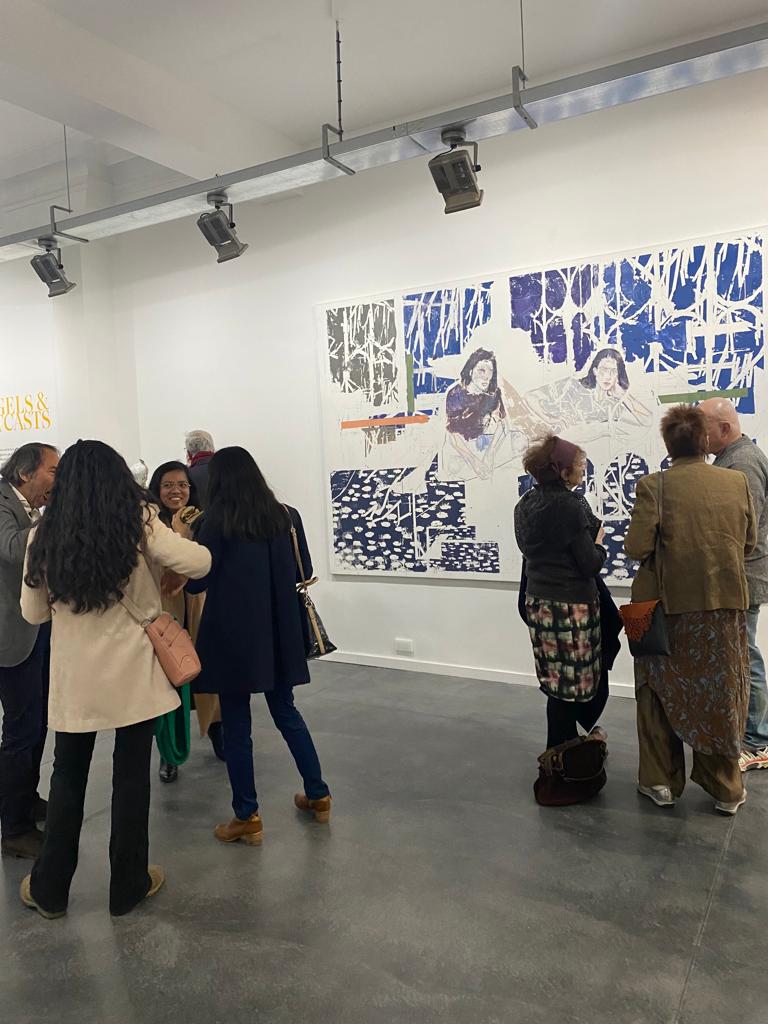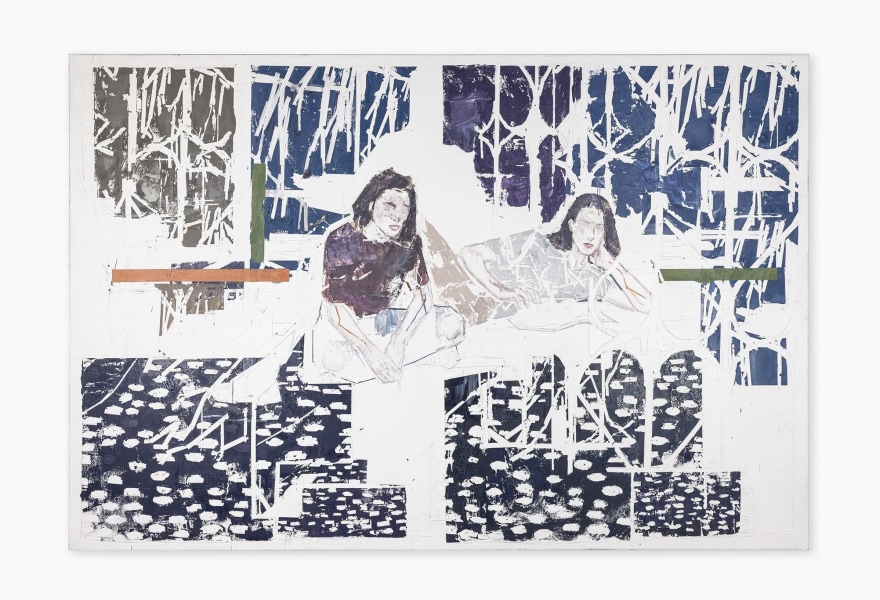06 may 2022, Manuela Klerkx
The painting of Alexander Tinei: A process from eighty to one hundred percent
For anyone who likes paintings that suggest a story rather than tell it, the exhibition 'Angels & Outcasts' by the Moldavian, Budapest-based Alexander Tinei (1967) is an absolute must. Tinei studied from 1988-1991 at the Chisinau Repin State College of Fine Arts in Moldavia and in the 00s he settled in the Western art world where he had his first international exhibitions in Budapest, Amsterdam and Belgrade. He is especially known for his sketchy portraits and figures of young people who bear traces of alienation and loneliness in the form of blue tattoos that culminate in vein lines running across their bodies. The atmosphere is simultaneously raw and romantic. The background, complete with white, blue and orange tape, almost blends in with the figures in the foreground, giving his 'flat' paintings a certain depth and layeredness that runs parallel with the emotion they evoke. When Alexander tells me during our conversation that he loves Johnny Cash's music ("especially the young ones"), I suddenly understand why I like his paintings so much: they are as heartfelt and true to life as Cash's songs.

Alexander Tinei, Le Café Arabe, 2022, NQ Gallery
‘I did the academy in post-Soviet Moldova. When I came to Budapest in '00, I practically lived in the library to brush up on contemporary painting.’
MK Are you happy with your first exhibition at NQ Gallery?
AT It was a challenge because I realised too late that I needed big paintings for the exhibition. There are artists who work on a project basis and show the result of their work in the gallery.
I don't work on a project basis but always create new work especially for the place where I am exhibiting it. The choice of paintings and the way I present them are very important to me. So the space also determines what I show and how.
MK Why do you work that way?
AT I want to surprise the visitor and myself by making the exhibition space my own. When I realised that the space required a number of large canvases, I only had a few weeks left. So I was under a lot of pressure and could not afford to make any mistakes. But actually it is always like that. Before a deadline, you are always under pressure and the fear that the exhibition will not be good comes over you. Just before the opening, I am always afraid that people won't like it and that that will mean the end of my career. Fortunately, it always turns out well.

Alexander Tinei, Mountains are crying too, 2017, NQ Gallery
AT No, when I was wrestling with the largest canvas for the exhibition, I really wondered why I always make things so difficult for myself. (laughs).
MK And why is that? You don't have to prove anything to yourself or the audience, do you?
AT That's right, but with this large painting I wanted to challenge myself and the visitor by showing that you don't have to paint a canvas full of things, but that it can also contain empty, white parts that speak for themselves. The painting consists of large uncovered areas. That was new to me. I felt like Cy Twombly.
MK What do you mean by that?
JVCy Twombly always takes big risks, too, and I wondered if how I felt making this canvas would be similar to how he felt. Twombly is very much about the interaction between the artist and the canvas, and although he's not a figurative painter and I am, there are similarities in approach.
MK Can you explain that?
AT We are both concerned with the 'touch' of the paint on the canvas, the way the interaction between paint and canvas takes place. It's not predictable because of the layered way of working.
MK Can you tell us a bit about your working method?
ATI have a huge digital database with all kinds of photos, from all over the world and on all kinds of subjects. In photoshop, I then make a composition of an image based on a selection from that digital photo material. When I am finished with such a composition or collage, I then go to the studio and project it onto canvas. I know in advance that almost 80% of it won't work, but then I set to work to build and arrange the canvas in such a way that it makes sense.
MK What inspires you to work that way?
AT What matters to me is not the message or the story, but the structure of a painting or the basis of an image that I have in my head.
MK Did you learn that method yourself?
AT Yes, because at the academy in Moldova where I studied, you learned how to paint but you didn't know how to express an idea. Only when I went to Budapest at the age of 30 did I discovered that I knew nothing about contemporary art. We were still educated with the knowledge and skills of the late 19th and early 20th centuries.

Alexander Tinei, Son of Dawn, 2022, NQ Gallery
MK When and how did you figure that out?
AT The first great painter whose work I was introduced to in the West was Gerhard Richter. I remember reading why he wanted to make paintings without colour, completely in black and white. That was a real shock to me after years of learning how to paint with colour in orde to become a good artist. I got so fascinated by Richter's work and thinking about art that I spent whole nights in the library brushing up on my knowledge. I discovered that contemporary art is not so much about knowledge and technical skills as it is about having a vision. That was a real eye-opener for me.
MK Which other artists in those early days were your teachers?
LV Marlene Dumas and Luc Tuymans. From them I learned that art is not about displaying knowledge and skills but about the question of what you want to express. They were in fact my artistic education. Dumas and Tuymans were the light at the end of my tunnel. Through them, I learned what contemporary painting is all about. That I could go on painting on the basis of projecting my digital collages and painting figures, but that I had to add something from my own imagination to give it value. I discovered that the meaning of colour, of a composition, or the skin of a canvas, was very different from what I had been taught. I had to reinvent myself. And when I'm in danger of losing control, I use the big guns. (laughs)(lacht)
‘If you are in danger of losing control in painting, you are forced to react.
I want more freedom to get better in losing control.’
MK And how did that process work?
AT I discovered that I could make my own image by attacking the painting, so to say. For example by treating it with an acid solution or by scrubbing, or sanding off the paint. In this way, a painting arose from the destruction of the previous layers.
MK That sounds pretty punk.
AT It is, because I really feel the need to destroy a painting if it doesn't feel real. I strive for genuine emotions, so I don't look for quality in perfection but in the energy, the emotion it evokes. It has to fit the times we live in.
MK Did you always know you wanted to be an artist?
AT When I came to the West and started working with galleries, I didn't dare call to myself an artist in the first place. I had finished art school, but didn't know anything about contemporary art in the eyes of the western art world. In fact, I realised that Andy Warhol, although already deceased, made more contemporary work than I did. His art touched me, went straight to my heart because it was rooted in his time. And I felt, I wanted to make art like that.
MK What kind of art exactly?
AT Art that is a reflection of the time in which it is made, without further illusions.
For example, tattoos are so popular at the moment that I incorporate them into my paintings, but because I don't like details I decided to paint them all over the body. Thus, those originally figurative tattoos turned into abstract, blue-coloured lines that, together with tape and pencil, I also use to divide the canvas into planes. By the way, talking about inspiring artists, I think Daniel Richter and Tal R are very good artists. They show how you can make flat paintings that still have depth and space without resorting classical concepts.
MK What is more important in art: energy or aesthetics?
AT I think energy. After Cézanne everything collapsed and since then we don't know what beauty is anyway. (laughs)

Alexander Tinei, NQ Gallery
